Massachusetts Home Inspections YOUR INVESTMENT IS MY CONCERN

Wet Basements

Few things are more frustrating than dealing with a wet or flooded basement. Damp basements and crawl spaces are major sources of excess humidity, which can lead to surface condensation, mildew, mold growth, musty odors, and an unhealthy living environment. Persistent moisture can also cause long-term damage to your home’s structure, including deterioration of foundation mortar, floor joists, beams, supports, subflooring, insulation, and even electrical and mechanical systems.
Prolonged water accumulation around the foundation and footer can soften the surrounding soil, reducing its load-bearing capacity and increasing the risk of foundation settlement and cracking. In more severe cases, seepage beneath the foundation can erode the soil, causing structural shifts and resulting in cracks—often in a V-shaped pattern—along the foundation walls.
Excess moisture may also travel upward, penetrating the subflooring and causing it to warp or buckle. This can lead to uneven floors and misaligned doors or closets that become difficult to open or close. In both basements and crawl spaces, moisture naturally migrates toward the drier areas of the home, raising indoor humidity levels and leading to higher heating and cooling costs. In crawl spaces specifically, moisture-soaked or sagging insulation can further increase energy expenses.
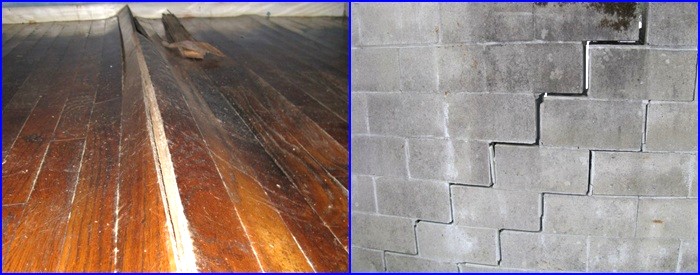
Beyond physical damage, persistent dampness in a basement or crawl space can significantly reduce a home’s value—at the very least, by the amount required to repair the damage and resolve the underlying issue. Unfortunately, some homeowners or sellers may be reluctant to disclose water problems, concerned that even the perception of moisture could negatively affect the property's market value.
Homeowner insurance that fully covers basement flooding damage is an important means of financial protection to homeowners. Coverage for wet basements varies from state to state and company to company. But typically, the damage from water seeping in from the outside or backing up from the sewer is not covered by standard homeowner policies. In some cases, special coverage can be purchased to cover these risks, but it is usually very limited in the types of personal property it covers and amounts of coverage that may be purchased.
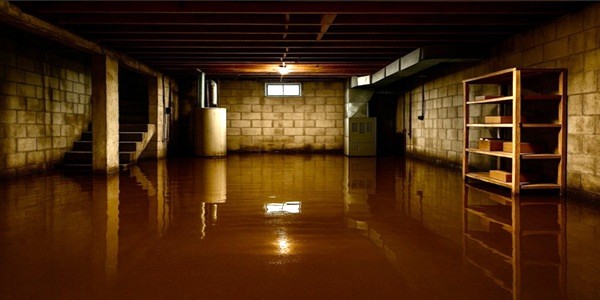
It's every homeowner's responsibility to understand how to prevent water damage before it starts. This begins with proper home maintenance and the installation of systems designed to divert or remove water before it ever reaches the basement. I speak from experience—living in a flood zone, I don’t get a single drop of water, even during multi-day storms. When I bought my home, I carefully evaluated the situation and addressed the existing issues the right way. Having performed thousands of home inspections and witnessed hundreds of flooded basements, I genuinely enjoy helping homeowners understand how to manage and reduce moisture around their homes.
CAUSE OF WET BASEMENTS AND CRAWLSPACES
Most wet basements or crawl spaces are the result of surface water accumulating around the home due to poor drainage. When water isn’t properly directed away from the foundation, it pools near the exterior walls. Over time, the saturated soil has nowhere else to drain—forcing moisture downward into the basement or crawl space.
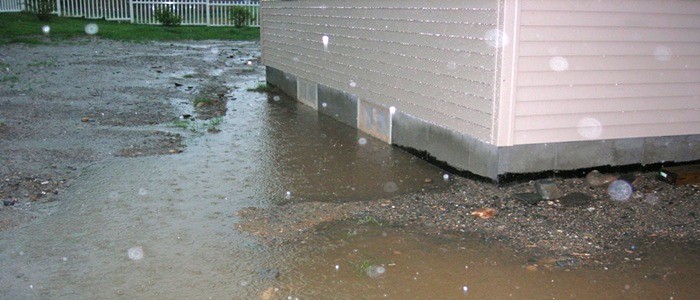
SOURCES OF WATER ACCUMULATION NEXT TO YOUR FOUNDATION
* Gutters and downspouts are either not currently installed, not properly extended away from the foundation, leaking at the seams, or clogged with debris such as leaves and bird nests. In any of these cases, roof water may not be effectively directed away from your home. This can lead to water pooling near the foundation, increasing the risk of moisture intrusion and potential structural damage over time.
Roof water, if not properly managed, can quickly accumulate. When downspouts (also known as leaders) are clogged or lack proper extensions to direct water away from the foundation wall, issues arise. Often, downspouts terminate right at the base of the house without an elbow and a 4-6 foot extension. This causes roof water to discharge directly at the foundation, allowing it to seep into the surrounding soil. For example, a typical 2,000 square foot roof can produce nearly 1,250 gallons of water during just one inch of rainfall. If rainfall is prolonged over several days, the likelihood of this water saturating the ground next to the foundation significantly increases, elevating the risk of basement leaks and water damage.
* Underground drains connected to downspouts may fail to function properly for several reasons: they may lack sufficient slope to carry water away, discharge into the yard and become buried under topsoil, get crushed during landscaping, become pinched at their outlets, or lead to low-lying areas where water collects and backs up. In all these scenarios, the result is the same—water backs up or overflows at the base of the downspout and eventually penetrates the foundation area.
* Excessive watering of flower beds and shrubbery around the foundation wall can lead to water accumulation near the home. Once the air spaces in the topsoil or mulch bed become saturated, any additional water either runs off or seeps into the ground adjacent to the foundation. Over time, prolonged or excessive watering can contribute significantly to moisture buildup next to basement walls, increasing the risk of water intrusion.
* Rainwater runoff from adjacent lawn areas, or improperly sloped driveways and walkways, can contribute to water pooling near your foundation if the landscaping directs water toward, rather than away from, the house. When surface runoff is directed toward the foundation wall, it can pool and eventually seep into the soil, becoming a potential source of moisture in the basement or crawl space. Additionally, downspout splash pads are ineffective if they discharge water onto a slope that drains back toward the foundation wall. In such cases, these splash pads offer little protection and can be considered ineffective.
* Basement or foundation walls can intercept or block subsurface or excessive groundwater. Homes built near downslope areas or at the base of hillsides are especially at risk, as surface water can saturate the soil uphill and flow downward, increasing groundwater levels near the foundation. Foundation walls often act like dams, trapping this water and creating pressure that can force moisture through joints and cracks in basement walls. It may also seep beneath the foundation footing, raising the water table and allowing moisture to rise through the concrete floor.
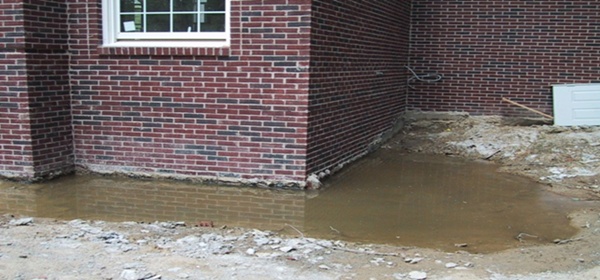
* Nearby springs may have been filled in or covered by the developer. If not properly drained away from the lot or subdivision, water from these springs can saturate the surrounding fill, forming a pool of groundwater. Over time, this groundwater can deepen and spread, potentially impacting neighboring properties by forcing its way laterally and upward into basements and crawl spaces.
* Nearby creeks can overflow during heavy storm runoff, directly flooding basements or crawl spaces, or contributing to rising groundwater levels. This groundwater may eventually reach a point where it seeps into lower areas of the home. Homeowners might not experience these issues for months or even years after purchasing the property, especially during periods of drought or when flooding is rare. However, when such events do occur, they can happen suddenly and without warning—often after the builder’s warranty has expired—leading to significant problems.
* Improperly installed, clogged, collapsed, or leaking footing drains can prevent downspout or foundation wall water from draining properly. Perimeter, footer, or foundation drains are typically installed around the exterior of a home, below the basement floor level, to intercept and redirect subsurface water, helping prevent groundwater buildup and seepage beneath the house. However, if these drains are poorly installed or become clogged with silt or roots, they can fail to function. In some cases, even a properly installed drain may be rendered ineffective if its outlet is accidentally covered during final backfilling or landscaping, leaving intercepted water with nowhere to go—resulting in pressure buildup and eventual seepage into the basement or crawl space.
* Soil in a crawl space can draw moisture upward from subsurface groundwater through a process called capillary action—much like a blotter absorbing liquid. This effect is especially strong in fine soils, such as clay, which promote more aggressive moisture movement. As the water reaches the surface, it evaporates into the crawl space, creating significant humidity even in the absence of standing water. A common sign of capillary moisture is a whitish residue on the ground surface, left behind by evaporating water that contains minerals and salts. Without a proper moisture barrier, such as a plastic sheet, this continuous capillary action can introduce a virtually unlimited source of moisture into the crawl space.
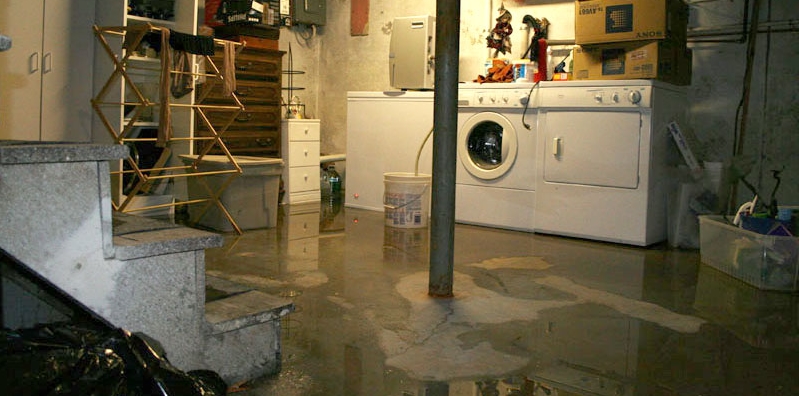
DRYING OUT A WET BASEMENT
If water is entering your basement, the first step is to determine whether it happens immediately after rainfall. If so, the likely cause is surface water pooling against the exterior basement walls—a common source of basement moisture issues. Fortunately, this is often a problem homeowners can address themselves.
✅ First, it’s important to identify the source of the water entry. Start by checking for ways exterior runoff could be reaching the basement. Ensure that downspout water isn't pooling or soaking into the soil near the foundation during a storm, and check that there are no leaks at gutter and downspout seams. Gutters should be properly collecting rainwater and directing it into the downspouts. Also, make sure the downspout inlets are clear of debris, which could prevent water from flowing properly. To prevent water from collecting near the foundation, downspouts should have extensions (underground is best) that direct water at least five feet away from the house.
✅ Inspect the ground around your foundation. Over time, the soil used for backfilling around most foundations tends to settle, often leaving the ground near the house lower than the rest of the yard. To prevent water from pooling, grading should slope away from the house by at least 1 inch for every 1 foot of horizontal distance. If the soil is already near the top of the foundation or if your lot slopes toward the house on one side, you may need an alternative solution. In this case, create a swale or shallow ditch on that side to channel surface water away from the foundation and direct it downhill toward the street. Position the drainage path as far from the house as possible. If there’s enough space, you can blend the ditch into the lawn to make it less noticeable.
✅ If there is pavement next to your house, ensure it slopes away from the foundation. If a driveway or sidewalk is level or slopes toward the house, you have a few options. One solution is to replace the pavement and correct the grading during the process. If it's concrete, you can opt for mudjacking (raising the surface), which is typically about half the cost of replacement. Another option is to add an additional layer of pavement next to the house to reverse the slope. If you choose this approach, be sure to caulk any joints and cracks in the driveway or sidewalk to prevent water from seeping through and reaching the basement.
✅ Window wells are another common source of basement water issues. The well should be deep enough to extend below the window sill, providing space to catch rainwater that may fall into it. The well should be sealed to the foundation with construction adhesive and the top rim of the well should be 3 to 4 inches above grade, with the surrounding ground sloping away to prevent water from being directed into the well. If the window well is located on a side of the house where wind drives rain or ice against the foundation, installing a plastic bubble cover over the well can help keep out rain, leaves, and snow.
Addressing grading issues, such as those mentioned here, will resolve the majority of basement water problems and should always be your first step—even if you’re considering additional measures like repairing a leaky crack in a poured concrete foundation. If that’s the case, I recommend contacting Crack-X, a Massachusetts-based company. They specialize in sealing cracks by injecting a specially formulated epoxy that stops water from entering your basement. This process not only closes the crack but also restores the structural integrity of the wall, creating a "weld" as strong and durable as the original concrete. Crack-X offers a 10-year warranty. You can reach them at 1-877-727-2259 or visit their website at http://www.crack-x.com.
SEVERE FLOODING IN BASEMENTS (Waterproofing)
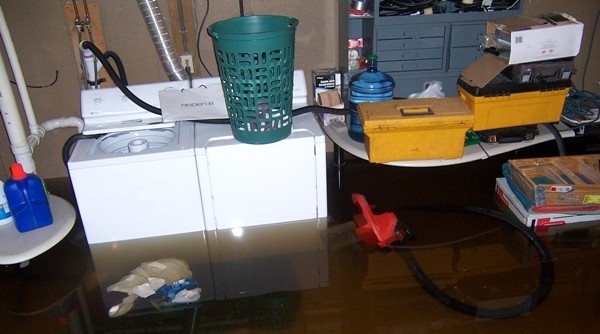
In my opinion, "waterproofing" systems—especially those installed on the exterior of a building—should be considered only as a last resort. Many of these systems involve collecting and discharging water, which can be quite costly. If you’ve tried all the recommendations I’ve provided and water is still flooding your basement, and you’re unable to resolve the issue on your own, it’s time to call in a professional basement waterproofing company in Massachusetts. Otherwise, consider installing an interior gutter system. This dam-and-channel system runs along the entire interior perimeter of your basement floor, collecting water that seeps through the foundation walls or onto the floor, then directing it to a floor drainage system and sump pump. If you decide to go this route, I highly recommend contacting B-Dry which is a Massachusetts based company. You can reach them at 978-262-1405 or visit their website at B DRY BOSTON. I’ve seen many of their systems in action, and they’ve consistently performed well.
Here is what my clients have to say about my home inspection services:
Press F5 (on your keyboard) for additional testimonials
Dave had an impressive website that seemed to be too thorough to be anything but genuine. The thing that seemed to sell me was that he says right on his website that you may pay a little more for his service, but that his quality is higher. So I decided to give him a try even though I had no reference from another person hoping for someone of top quality. I was not disappointed. He was at the home early as promised and had done an inspection of the exterior and was writing up notes so that when I arrived, he walked me through the exterior first. Even with his early arrival, we were still there for about 3 hours looking through every little corner and cubby. He would occasionally stop and fill out his inspection forms which were easy to follow and read; he gives you a full folder of his notes that are well organized.
Dave was open to all questions and concerns so every time I saw something that was potentially concerning to me, he would look, give his opinion and often shared other experiences with similar circumstances. He also had a good sense of humor which helped to lighten what can be a stressful experience (having someone pointing out problem items that you didn't see). I would highly recommend Massachusetts Home Inspections.
Michael














